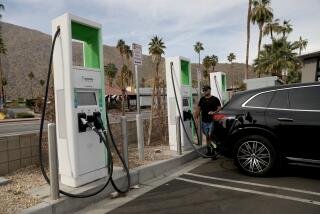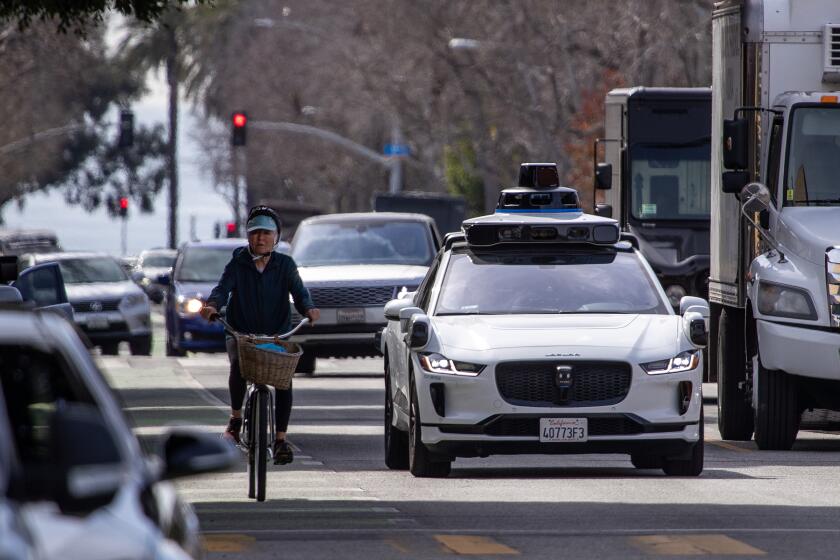Gas price fears give U.S. auto sales a lift in February
- Share via
Auto sales surged in February, bolstered in part by consumers concerned about gas prices migrating to smaller, fuel-efficient cars.
Pushed by “a tailwind of rising fuel costs,” small cars are now making up a bigger slice of Ford Motor Co.’s sales, Ken Czubay, the automaker’s U.S. sales chief, said Tuesday.
The company is capitalizing on customers such as Cynthia Hibbard of Torrance, who replaced an aging Nissan Sentra with a new Ford Fiesta from Power Ford in Torrance last month.
“With everything happening in the world, gas is only going to go up,” said Hibbard, who expects the Fiesta to get better mileage than her previous car. “I have filled it up just once, on Monday, since the car was purchased. I put just nine gallons of gas in the car but that was still $35.”
Hybrids also are starting to pick up steam. Michael Lorimer of Camarillo recently traded in an Infiniti QX56 sport-utility vehicle at Galpin Ford of North Hills for a Ford Fusion hybrid.
“We saw what was going on with gasoline, and it just didn’t make sense to keep a vehicle that got only 13 miles to the gallon. We went and got a car that gets triple the gas mileage,” Lorimer said. He estimates he will save more than $150 a month on gasoline.
Toyota Motor Corp. said it sold more Prius hybrids in February than in any other February.
“That is where the customer is going, particularly with all the speculation as to how high is up with gas.... We are going to have a very good hybrid spring,” said Bob Carter, Toyota Division group vice president.
Smaller vehicles also are becoming a more significant part of General Motors Co.’s sales.
Its Chevrolet division sold about 48,000 vehicles with four-cylinder engines in February — about a third of all Chevrolet sales for the month. That compared with 40,000 in January and just 25,000 in February of last year.
Total U.S. new-vehicle sales rose more than 27% compared with the same month a year earlier to nearly 1 million vehicles, according to industry tracker Autodata Corp. That equals a seasonally adjusted annual sales pace of 13.4 million, the highest sales rate since the level of 14.2 million seen during the “cash for clunkers” economic stimulus program in July and August 2009, Autodata said.
“The consumer is back to the showrooms,” said Brian Johnson, an analyst with Barclays Capital.
Certainly that was the case for GM, whose February U.S. sales rose 46.4% compared with a year earlier to 207,028 vehicles, Autodata reported.
The automaker said its retail sales grew 70% over February 2010 and that its sales to car rental companies and commercial users were about even with a year earlier. The gain in the retail market was the highest year-over-year jump in GM’s history.
Trucks also were big sellers in February based on “a resurgence in the economy and the replacement of vehicles.... People are buying for need, either to add to their fleet as their business is growing or because their truck is worn out and they need that type of capability for business,” said Don Johnson, GM’s U.S. sales chief.
That’s created a bifurcated market in which truck sales will remain strong in the face of rising fuel prices, while small-car and small-SUV sales will continue to climb, said Jesse Toprak, an analyst at TrueCar.com.
Dealers are just starting to see a new wave of customers looking to trade in gas guzzlers for more fuel-efficient vehicles because of the recent gas price jump, said Beau Boeckmann, vice president of Galpin Ford, the nation’s largest Ford dealership.
That is reminiscent of a 2008 fuel price spike that sent sales of small cars and hybrids soaring.
From March through July of that year, the percentage of shoppers looking into hybrids at auto information website Edmunds.com ranged from 11% to 18.8%. Gas prices at that time fluctuated from $3.26 to $4.09 a gallon.
For the week that ended Monday, the average U.S. price of a gallon of regular gasoline leaped to $3.383, up 19.4 cents from the previous week, the Energy Department said, following oil prices higher on unrest in Libya and the Mideast. That was 68 cents higher than a year earlier, bringing the average to an all-time high for this time of the year but still well below the national record of $4.114 a gallon reached in July 2008.
In California, the average climbed 16.4 cents to $3.719. That was 72 cents higher than the year-earlier price, and experts predicted that the state’s average would top $4 a gallon in the coming weeks.
Retail sales of Ford’s small cars — the Fiesta and Focus — were more than double year-earlier levels.
Ford’s total February sales rose 13.7% compared with a year earlier to 156,232.
Toyota said its February sales rose 41.8% to 141,846 vehicles. Johnson of Barclays Capital cautioned that the gain was deceptive, saying it was “the result of a very easy comparison versus last year, when its sales suffered from safety concerns.”
Toyota has issued product recalls of more than 13 million vehicles since September 2009 in the U.S. alone, including the recall of more than 2 million vehicles to correct problems with floor mats and other issues that could cause unintended acceleration. Toyota briefly stopped selling many of its popular models last year to fix sudden acceleration problems.
Still, Toyota officials were pleased with the result.
“After two months of improving sales, we feel good about the way 2011 has started,” Carter said.
More to Read
Inside the business of entertainment
The Wide Shot brings you news, analysis and insights on everything from streaming wars to production — and what it all means for the future.
You may occasionally receive promotional content from the Los Angeles Times.











